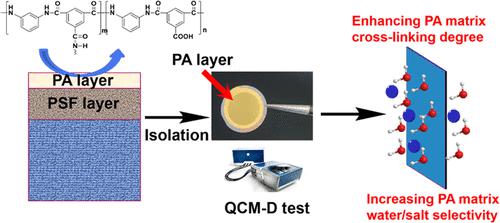当前位置:
X-MOL 学术
›
ACS Appl. Polym. Mater.
›
论文详情
Our official English website, www.x-mol.net, welcomes your
feedback! (Note: you will need to create a separate account there.)
Water/Salt Transport Properties of Polyamide Reverse Osmosis Membranes Using Quartz Crystal Microbalance
ACS Applied Polymer Materials ( IF 4.4 ) Pub Date : 2023-08-29 , DOI: 10.1021/acsapm.3c01194 Mingguang Hu 1 , Chenchen Zhang 1 , Meng You 2 , Jianqiang Meng 1
ACS Applied Polymer Materials ( IF 4.4 ) Pub Date : 2023-08-29 , DOI: 10.1021/acsapm.3c01194 Mingguang Hu 1 , Chenchen Zhang 1 , Meng You 2 , Jianqiang Meng 1
Affiliation

|
Thin-film composite (TFC) reverse osmosis (RO) membranes prepared by interfacial polymerization of M-phenylene diamine (MPD) and trimesoyl chloride (TMC) are the most widely used membranes in the current desalination market. However, how to accurately and quantitatively describe the permeation process that quantifies the water/salt partition coefficient (K) and the diffusivity coefficient (D) of the polyamide matrix in the polyamide active layer remains a challenge. Herein, the water and salt transport properties of polyamide (PA) TFC membranes are systematically investigated for the first time based on the quartz crystal microbalance with dissipation (QCM-D), and the relationships between structure and transport properties are investigated. The change of water/salt participation (Kw and Ks) with the TMC concentration is much more sensitive than that with the MPD concentration increase. The Kw slightly changes with increasing monomer concentrations, while the Ks increases first and then remains almost unchanged with an increase in the TMC concentration. There is a significant reduction of the Dw and Ds of the polyamide matrix by enhancing the cross-linking degree as the TMC concentration increased from 0.05 to 0.125%. Enhancing the cross-linking degree of the polyamide matrix by adjusting the monomer concentration is beneficial to improve water/salt diffusivity selectivity. The evolving trend of permeability is consistent with the diffusivity, indicating that the permeability of the polyamide TFC membrane is mainly determined by the diffusivity of the polyamide matrix. In conclusion, varying the TMC concentration is more likely to change the physicochemical properties of the polyamide active layers, including water/salt transport properties.
中文翻译:

使用石英晶体微天平测定聚酰胺反渗透膜的水/盐传输特性
由间苯二胺(MPD)和均苯三甲酰氯(TMC)进行界面聚合制备的薄膜复合(TFC)反渗透(RO)膜是当前海水淡化市场中应用最广泛的膜。然而,如何准确、定量地描述渗透过程,量化聚酰胺活性层中聚酰胺基体的水/盐分配系数( K)和扩散系数(D )仍然是一个挑战。在此,基于耗散石英晶体微天平(QCM-D),首次系统研究了聚酰胺(PA)TFC膜的水和盐传输特性,并研究了结构与传输特性之间的关系。水/盐参与的变化(K w和K s )随TMC浓度的增加比随MPD浓度的增加敏感得多。随着单体浓度的增加,K w 略有变化,而 K s随着TMC浓度的增加先增加,然后几乎保持不变。D w和D s显着降低随着 TMC 浓度从 0.05% 增加到 0.125%,聚酰胺基体的交联度得到提高。通过调节单体浓度提高聚酰胺基体的交联度有利于提高水/盐扩散选择性。渗透率的演变趋势与扩散率一致,表明聚酰胺TFC膜的渗透率主要由聚酰胺基体的扩散率决定。总之,改变 TMC 浓度更有可能改变聚酰胺活性层的物理化学性质,包括水/盐传输性质。
更新日期:2023-08-29
中文翻译:

使用石英晶体微天平测定聚酰胺反渗透膜的水/盐传输特性
由间苯二胺(MPD)和均苯三甲酰氯(TMC)进行界面聚合制备的薄膜复合(TFC)反渗透(RO)膜是当前海水淡化市场中应用最广泛的膜。然而,如何准确、定量地描述渗透过程,量化聚酰胺活性层中聚酰胺基体的水/盐分配系数( K)和扩散系数(D )仍然是一个挑战。在此,基于耗散石英晶体微天平(QCM-D),首次系统研究了聚酰胺(PA)TFC膜的水和盐传输特性,并研究了结构与传输特性之间的关系。水/盐参与的变化(K w和K s )随TMC浓度的增加比随MPD浓度的增加敏感得多。随着单体浓度的增加,K w 略有变化,而 K s随着TMC浓度的增加先增加,然后几乎保持不变。D w和D s显着降低随着 TMC 浓度从 0.05% 增加到 0.125%,聚酰胺基体的交联度得到提高。通过调节单体浓度提高聚酰胺基体的交联度有利于提高水/盐扩散选择性。渗透率的演变趋势与扩散率一致,表明聚酰胺TFC膜的渗透率主要由聚酰胺基体的扩散率决定。总之,改变 TMC 浓度更有可能改变聚酰胺活性层的物理化学性质,包括水/盐传输性质。































 京公网安备 11010802027423号
京公网安备 11010802027423号